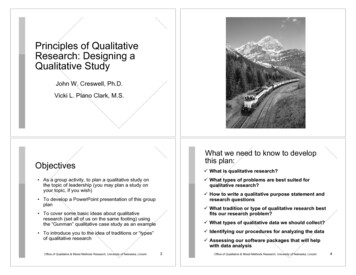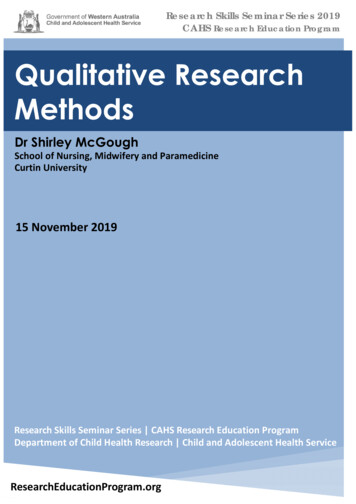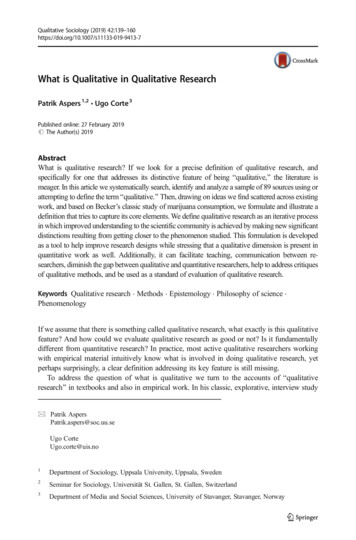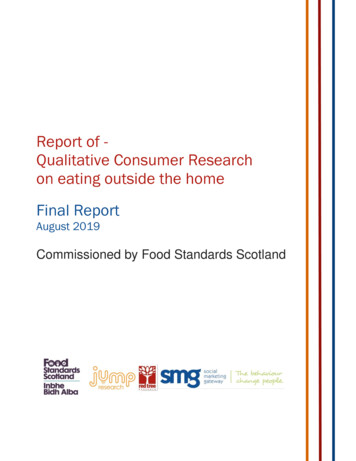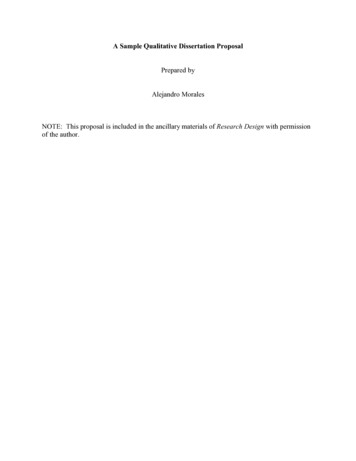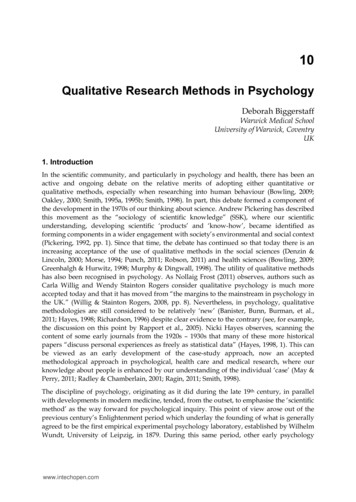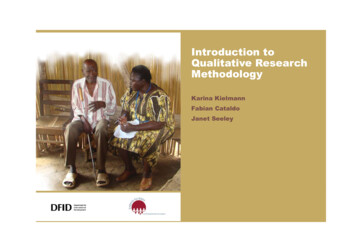
Transcription
Introduction toQualitative ResearchMethodologyKarina KielmannFabian CataldoJanet Seeley
Karina KielmannFabian CataldoSenior Lecturer in International HealthInstitute for International Health & DevelopmentQueen Margaret UniversityEdinburgh, Scotland EH21 6UUEmail: kkielmann@qmu.ac.ukResearch Director - MalawiDignitas InternationalP.O. Box 1071 Zomba; MalawiE-mail: f.cataldo@dignitasinternational.orgFabian Cataldo is a social anthropologist specialised in questions related tohealth systems and access to treatment and care in low income settings.Over the past 15 years he has undertaken extensive fieldwork in Brazil, Belgium,Tunisia, Zambia, Uganda, Zimbabwe, Mozambique and Malawi. He is currentlythe Research Director of Dignitas International, a medical and research NGObased in the South-East of Malawi.Karina Kielmann is a medical anthropologist who has been working in internationalpublic health since 1998. Her specific areas of interest include critical analyses ofpublic health paradigms, patient-provider communication, and bioethics in lowresource settings. She has worked in Kenya, Tanzania, Burkina Faso, India, Zambia,and South Africa. At the time of production of this manual, Karina was based inthe Department of Global Health and Development, London School of Hygieneand Tropical Medicine.Janet SeeleyProfessor of International DevelopmentSchool of International DevelopmentUniversity of East AngliaNorwich, NR4 7TJ, UKE-mail: j.seeley@uea.ac.ukandHead of the Social Science ProgrammeMRC/UVRI Uganda Research Unit on AIDSP.O. Box 49, Entebbe, UgandaE-mail: janet.seeley@mrcuganda.orgJanet Seeley is a social anthropologist by training. Over the last 30 yearsshe has undertaken extended periods of research in Kenya, Uganda, Zambia,India, Nepal, Bangladesh, Pakistan, and Papua New Guinea focusing on broaderaspects of people’s lives and livelihoods which influence health and healthrelated behaviour. She is currently Professor of International Developmentat the University of East Anglia and Head, Social Science Programme,MRC/UVRI Uganda Research Unit on AIDS, on partial secondment to theMedical Research Council (UK).Edited and Designed by Write-Arm (www.write-arm.com) December 20112
ContentsC H A P T E R 1 .6C H A P T E R 2 .12C H A P T E R 3 .18C H A P T E R 4 .24C H A P T E R 5 .33C H A P T E R 6 .41C H A P T E R 7 .47C H A P T E R 8 .53C H A P T E R 9 .64Next Steps .70End Notes .71Feedback on Exercises .72Optional Exercises .76The Qualitative LensThe Quantitative - Qualitative ContinuumIssues in the Design of Qualitative ResearchInterviewsGroup InterviewsObservationFieldworkEthics and Logistics of Data CollectionSteps Towards Data AnalysisQualitative Research Methods - A List of Useful References . 79Acknowledgements .82Appendix A - Example of a Focus Group Discussion Guide .83Appendix B - Example of an Interview Guide - . 84Semi-Structured Interview3
PrefaceIt introduces qualitative methods in an interesting andhands-on way to provide you with an understanding of keyconcepts and methods in qualitative research as appliedto the field of health.About the manualAll three authors are trained anthropologists who havebeen working in health and development for many years.They have conducted research, taught, and built capacityfor qualitative and applied anthropological research in differenttypes of health settings in a variety of countries.This manual is based on a course entitled ‘Qualitative Research Methodsfor Non-Social Scientists’ which was developed by the authors, andrun in Entebbe, Uganda, in March 2010. The course was part of thecapacity building efforts of the Evidence for Action Research ProgrammeConsortium, funded by the Department for International Development,UK1. The participants came from Zambia, Malawi and Uganda, mostwith clinical backgrounds in HIV. Their high levels of motivation andenthusiasm for the course and their desire to build on what they hadlearnt led to the idea of this manual. Aimed primarily at non-socialscientists, the manual is also accessible to a wider audience.Purpose of the manualThe manual can be used as a stand-alone, self-learning toolby individuals new to the use of social science methodsin health research; it can also be used by social scientiststasked with conducting short-term training in qualitative researchmethods for applied health research.The authors have drawn extensively on their ownexperiences of teaching and using qualitative research methods,but they have also tried to synthesise many important insightsgained from teachers, colleagues, and scholars, some of whom havebeen acknowledged in the previous section. There are, of course,many excellent manuals and websites providing introductions toqualitative methods. The objective here is to complement thesemore in-depth sources with an overview that introduces the userto the topic and approach. If you would like more informationon the different topics covered, an annotated list of other usefulreferences is provided on page 79.4
Learning objectivesWe emphasise throughout the manual - but particularly in Chapter 8 - thatqualitative research is not just about applying a different set of tools togain knowledge, but rather, involves a fundamental shift in the approachto research, and description of reality.As you go through this manual, you will learn how to: Understand and describe theoretical and methodologicalassumptions underlying qualitative research Distinguish between quantitative and qualitative approachesto research and data Formulate qualitative research questions Recognise when and where to use qualitative research methods Make practical and logistic decisions in preparation forundertaking qualitative research Develop and apply basic study instruments for collection ofqualitative data Record and manage qualitative data Prepare qualitative data for analysisTo aid learning, we combine short texts that introduce key concepts withexamples to help you understand the ideas and reflect on their application.The chapters are also interspersed with Boxes, Examples, and Exercises toenhance your learning. Exercises will not only check your understandingof the concepts, but also encourage you to apply some of the gained skillsyourself. Feedback on the exercises is provided at the end of the manualso that you can check that you are on the right track.We hope you enjoy working with these materials. While we cannotprovide distance learning support we would very much welcome anycomments you might have on this manual. You can send your comments toQualitative.research.manual@gmail.com.Structure of the manualThe manual is organised around three main goals: First, to introduce you to qualitative thinking and aqualitative approach in research (Chapters 1 and 2) Second, to equip you with knowledge to be able to planand conduct selected qualitative research methods(Chapters 3 to 6) Third, to enable you to process the textual data obtainedthrough these methods, and to undertake preliminary stepstowards analysis of qualitative data (Chapters 7 to 9)5
C H A P TE R 1The Qualitative LensE X A M P L EC H A P TE R 1The Qualitative LensConsider the following three descriptions of ‘poverty’.What does each of them tell you about poverty and how does it do so?Learning objectives“Rural poverty in Tanzania has been halved in the period from 1985 to 2001.At present about 38 per cent of people living in rural areas are classified as poor.This progress is reflected in the United Nations Development Programme's HumanDevelopment Index for Tanzania, which rose from 0.3 in 1991 to 0.4 in 2002.”2A.This chapter will help you to: Understand how theory influences methodology Distinguish qualitative from quantitativeresearch on the basis of key features Adopt a qualitative lens to health-relatedquestionsB.Key words:positivism; constructivism; meaning; context; humanism;holism; interpretive; refl exive; naturalistic; iterativeIntroductionC. 3 “Poverty is like living in jail, living under bondage, waiting to be free.”— a saying from Jamaica “If you want to do something and have no power to do it,it is talauchi (poverty).” — a proverb from Nigeria “For a poor person everything is terrible - illness, humiliation, shame.We are cripples; we are afraid of everything; we depend on everyone.No one needs us. We are like garbage that everyone wants to get rid of.”— a blind woman from Tiraspol, MoldovaWhat is reality? How do we make sense of it? Research in all fields of studyfocuses on finding and validating new ways to investigate and understandreality. The methods adopted to define and measure aspects of the natural,material, and social worlds depend very much on the individual researcher’sbackground, training, interests, and familiarity with the subject. At thesame time, researchers may have fundamentally different ways of thinking(theories) about the social and material world around them. In this chapterwe begin to appreciate the ways in which a qualitative research approachdiffers from a quantitative research approach; we also see the ways inwhich the two methodological approaches complement each other.1. How did each of the three examples describe or explain poverty?2. What made the second and third examples so different from the first?3. Which description did you find most convincing? Why?6
C H A P TE R 1Theory and methodThe Qualitative LensFigure 1: The relationship between theory and methodYou will most probably agree that all three depictions of poverty constitutevalid forms of representing poverty. However, (A) uses numbers to quantifypoverty, that is, to provide an absolute numerical value or assessmentof the magnitude in poverty levels in a specific setting. These numbersare produced by using quantitative methods that prioritise a particulardefinition of poverty through socio-economic indicators. In contrast,the photo in (B) and quotes in (C) are derived through the applicationof qualitative methods – they suggest that measuring poverty is onlymeaningful when represented in subjective ways, that is, in words orimages that show us what it means to be poor. These also broaden ourunderstanding of poverty, as they tell us that being financially badly offmay also translate into feelings of inferiority and shame, and experiencesof illness and powerlessness.THEORYFURTHER DATA COLLECTIONHYPOTHESIS / QUESTIONSINTERPRETATION / ANALYSISRESEARCH STRATEGYMETHODOLOGY /DATA COLLECTIONQuantitative and qualitative approaches can also be understood bycontrasting the differences between two philosophical positions about thestate of reality: positivism and constructivism.Thinking about the differences in these three depictions of povertyintroduces us to the idea that the reality of a given social phenomenon hasdifferent dimensions, and that these dimensions can be captured throughdifferent lenses. By lens, we mean here the ways in which a researcherframes what s/he is looking for with the help of a theory and theoreticalassumptions. These assumptions, in turn, shape the choice of methodsthat generate what is considered valid data.Quantitative research, in general, holds a more positivist view of the world;it suggests that reality is something tangible that can be objectivelymeasured with the help of observational and experimental methods.Qualitative research generally adheres (although not always) to aconstructivist view of the world, one that suggests that reality is in theeye of the beholder; in other words, that there is no single reality for agiven phenomenon, but multiple, relative dimensions of reality which canonly be partially captured using subjective, naturalistic methods.Research of any type is a cyclical rather than a linear process; methodologicalchoices and methods themselves are not neutral but are always influencedby the assumptions you make about your subject of study. Your use oftheory is related to your training, your reading of the relevant literature,your political positioning and so on – in short, what you hold to be a validpicture or explanation for the phenomenon under study. Theory shapes thequestions you think are worth asking, which in turn determine a researchstrategy. The strategy (study design) helps you choose appropriate methods.Particular methods yield data sets which you analyse and which may leadto further questions. In turn, new and unexpected data help to refinetheoretical assumptions. This cyclical process is depicted in Figure 1.7
C H A P TE R 1Qualitative insights in health and illnessAs a qualitative researcher working in health you will pay close attentionto the subject’s social reality – social ties, ‘culture’, economic andenvironmental conditions etc. – and how this reality shapes the ways inwhich people talk about and experience health and illness. You will focus,for example, on:Quantitative methods provide a broad picture when used to collect dataon health, risk, illness, and health-seeking behaviour. They help to answerdescriptive questions such as: What is going on? What is the scope of theproblem? How is the problem changing over time? They are also used toassess similarities, differences, and associations (for example, of a riskfactor with a given illness) in the data through statistical analysis. It isimportant to recognize that the quantitative researcher has to make fixeddecisions about what s/he is going to measure and compare. Experiences of illness, or of interactions with different health careproviders. Listening to people’s experiences provides stories or‘narratives’, which are the data needed to understand the natureand complexity of illness and health-seeking episodes and thefactors affecting them Knowledge and understanding of a given issue, for example people’sunderstanding of the body and health in a certain cultural context,which influences their interpretation of an illness and how it wascaused, and also the course of action they have taken to treatthe illness Meanings derived by people based on their knowledge andexperience. People attach meaning to things, events, relationshipsand the world at large to make sense of their lives and theirexperiences. For example, if they are diagnosed as HIV-positive,they are likely to attach a great deal of meaning to this, basedon the ways in which HIV is conceptualised in their particularsetting: they may feel that life is not worth pursuing any more,that they have failed their close relatives, or that they are somehowimpure and that their social status has collapsed; or they mayreconstruct their self image - it can give them new meaningand purpose in life Explanations and rationale given by people to justify their decisionsand actions - the ‘whys’ and ‘hows’ of people’s actions andresponses to events that affect them. For example a person withdiabetes may have frequent experiences of hypoglycaemiafollowing his/her regular daily activities, which means s/he decidesto maintain a higher blood sugar than recommended at the clinic,for safety and to avoid the nuisance of low blood sugar. This is arational decision from the patient’s point of view. People explainQualitative research on the other hand, does not take categories of health,risk, and illness for granted. Instead the qualitative researcher tries toascertain how people who experience these conditions themselves definewhat they are going through, when they decide to seek treatment, whathappens when they seek treatment, how their experience of illness impingeson their lives and so on.These differences in the research ‘lens’ and methodology can be crudelycontrasted in the ways epidemiologists and anthropologists study health,risk, and illness (see Box 1).BOX 1: CONTRASTING EPIDEMIOLOGICAL AND ANTHROPOLOGICALRESEARCH ON ILLNESSEpidemiologyAnthropologyHow much disease is there?How is illness recognized and classified?What risk factors areassociated with the disease?What do risk factors meanin a context?What is the measurable risk ofobtaining specific outcomes?How do people interpret, respondand cope with risk and illness?The Qualitative Lens8
C H A P TE R 1their decisions and course of action as being beneficial and‘making sense’ in their everyday life context Social institutions (norms and rules) that govern people’s livesand dictate expectations and behavioural norms can also bederived from qualitative data. For example, in most societiesthere are ‘rules’ about courtship, marriage and childbirth that peopleare expected to adhere to, for example: no sex before marriage;seeking the father’s permission for marriage; payment ofdowry or bride-wealth; the importance placed on having childrento sustain the kinship line; the expectation that wives shouldmeet the sexual demands of their husbands, and so on. Of coursethese ‘rules’ are not always followed – people have sex beforemarriage and outside marriage, they may not pay bride-wealth.However, norms still influence their own lives and how theyjudge others who deviate from the norms Social processes, that involve how people communicate and interactto fulfil social goals, for example, how people negotiate, bargainand make decisions within a household - decisions about whereto take a child for treatment, or decisions about how to allocatemoney to different priorities. Also, there are questions about howand when people choose to act collectively based on what theyexperience as a shared condition, for example, in a show ofsolidarity, or in the form of a self-help group, or as a way to moreeffectively access support or resourcesThe Qualitative Lensresearchers are constantly trying to make sense of what they see and hearin a specific context; their approach to understanding what is going on isinterpretive, in other words, their aim is more often to explain rather thanto merely describe. Finally, as we have already said, how the data gatheredon people’s experiences are interpreted depends much on the researcher’stheoretical presuppositions and background. Qualitative researchers,more than quantitative researchers, generally adopt a reflexive positionvis-à-vis their research, in other words, they are explicit about how theirpersonal history and biography shape the questions asked, the framing ofthe research and the presentation of data.As we will see in later chapters, these four characteristics of qualitativeresearch require a different methodological approach. Methods in qualitativeresearch are generally open-ended and in-depth, and naturalistic, thatis, they attempt to study things, people and events in a natural (nonexperimental) setting.The methodology is flexible because it may use multiple methods toexamine the same question or area (‘triangulation’, discussed in Chapter2), and iterative. Iteration refers to questions or studies that are repeatedover time with the same informant or group of informants. This is feasiblewhen a researcher has access to the same informant over the course of astudy, and is useful when new questions arise, or the researcher wants togo back and check some of the data s/he has analysed.Key features ofqualitative methodologyAs suggested above, qualitative research is humanistic because it focuseson the personal, subjective, and experiential basis of knowledge andpractice. It is holistic because it seeks to situate the meaning of particularbehaviours and ways of doing things in a given context (as opposedto isolating these as a quantitative researcher would). These featuresinfluence two other characteristics of the qualitative approach. Qualitative9
C H A P TE R 1The Qualitative LensIterative methods are also useful when a subject is relatively unexploredor sensitive, and may require more time to develop rapport, trust, and theability to probe further. (see Box 2).BOX 2: ITERATIVE METHODSA study of sexual and reproductive health of adolescent girls might includea series of in-depth interviews over a period of time to progressivelyexplore areas such as: What it means to ‘grow up’ Familial, social and gendered context of adolescence Everyday perceptions/experiences of physical/mental changes Perceptions of the body in health and illnessA participant in a study in Uganda, and her interviewer (Source: Grace Tumwekwase) Perceptions/reported experiences of menstruation, sexuality,sexual and contraceptive behaviourFinally, qualitative research can complement quantitative data. Forexample, a qualitative phase of research might precede quantitative datacollection in order to explore a new area, to generate hypotheses, or tohelp develop data collection instruments. In turn, qualitative researchmight follow a quantitative phase of research in order to elucidate andexplain the ‘numbers’ or to probe the issues more in depth with a smallernumber of individuals.10
C H A P TE R 1NOTESC H A P TE R 1The Qualitative LensEXERCISE 1Please look at the following quantitative data on utilisation of maternal healthservices in Kenya (Source: UNICEF)Antenatal care coverage (%), At least once, 2005-2009*92Antenatal care coverage (%), At least four times, 2005-2009*47Delivery care coverage (%), Skilled attendant at birth, 2005-2009*44*Data refer to the most recent year available during the period specified.Notes:Antenatal care - Percentage of women aged 15-49 years attendedat least once during pregnancy by skilled health personnel(doctors, nurses or midwives).Skilled attendant at delivery - Percentage of births attended byskilled health personnel (doctors, nurses or midwives).Please consider the following questions:1. What do they tell you in quantitative terms?2. What do they not tell you?3. Formulate three qualitative questions you might ask about this data.11The Qualitative Lens
C H A P TE R 2The Quantitative - Qualitative ContinuumE X A M P L EC H A P TE R 2An interviewer seeking information about your educational backgroundcould frame the question in different ways, such as:The Quantitative Qualitative Continuum Learning objectivesThis chapter will help you to:How many years of formal schooling do you have? Or What is your level of education? Or Tell me about your schooling. Or Tell me about the major learning experiences in your life.Let’s start with your childhood.In what ways do the questions differ and how might yourresponses differ? Why? Distinguish between less and morestructured methods Make and justify methodical choicesin your researchThe methods continuumKey words:structured methods; unstructured methods;methods continuum; etic; emicAll methods can be situated along a continuum from highly structuredto less structured, which refers to the degree of structure expected atthe point when questions are asked, in other words, when the data edStructuredAlthough some questions are undoubtedly quantitative (for example, thosestarting with ‘how much.?’ or ‘how many.?’ or those demanding a yes/noresponse), in general, questions are not ‘quantitative’ or ‘qualitative’ per se.Rather, whether they generate quantitative or qualitative data depends onyour approach to what you are setting out to ‘measure’, for example, howmuch is known about the phenomenon under study, what kinds of answersyou expect to hear or find, and how you want to present the data.Research methods are often categorised as being either quantitative orqualitative, in other words, in terms of a dichotomy. Here, we suggest thatthis dichotomy presents a false divide, often argued along disciplinarylines (e.g., natural versus social sciences) and that it is more useful tothink of methods along a continuum. Rather than simply a distinctionbetween methods that produce numbers versus those that produce words,we suggest here that the important difference lies in how questions areasked and what kinds of responses we encourage from informants, how werecord responses, and what we do with this data.The more you pre-structure the categories of response you are interested in(for example, by coding expected responses), the more closed-ended thedata will be, lending themselves to quantitative analysis. The very same12
C H A P TE R 2The Quantitative - Qualitative ContinuumFigure 2: Social map created throughparticipatory data collectionquestions can, however, generate open-ended data when framed differentlyand left un-coded by you. Hence, the question from the above example,“Tell me about your schooling” might generate a fairly long, narrativeresponse in which the informant talks about the locations, time periods,and achievements during his/her school years. You may, however, havealready categorised the responses you expect to hear in terms of levels ofschooling, and may only record a tick in the box that corresponds to thehighest level of formal schooling achieved. Another researcher, however,may take detailed notes on the narrative provided. The question is thesame, but the way the response is recorded and analysed is different.Overview of methodsAll methods are based on some form of interview or observation. Asdiscussed in Chapter 1 and above, some of the main differences in methodslie in the relationship between the researcher and the subject, the levelof structure determined by the researcher, the type of data generated, andhow these data are recorded. Quantitative research tends to use structuredmethods that anticipate a limited set of responses and generate datathat are already in the form of counts or measurements, or can be readilyquantified. The relationship to the subject of study is distanced, with theresearcher maintaining full control over the data collected.responses. You have less control over the data, as the informant’semic (their own) perspective is ‘privileged’. In some cases, informantsthemselves participate in data collection, thus shaping what emerges asthe final picture. Qualitative data can also include secondary sources suchas historical accounts, press cuttings, and other documentary materials.In contrast, qualitative research tends to use less structured and nonstructured methods that address the questions about ‘why’ and ‘how’ aparticular health-related phenomenon exists rather than ‘what’ and ‘howmuch’. These methods generate non-numerical data, usually as text, butsometimes in the form of maps, pictures, and audio and visual recordings(see Figure 2). As we will see in later chapters, as a researcher you mustdevelop a relationship with your informants in order to obtain in-depthdata. Here, you do not have a fixed idea about what you will hear fromthe informant, and will use ways of eliciting information that encouragereflection and longer answers rather than a limited set of possibleQualitative and quantitative research both use interviews and observationsas key methods in research. Figure 3 shows how different types of interviewsand observations (some of which will be presented in the following chapters),can be placed along the quantitative-qualitative continuum. Do not worryfor the moment about the different methods listed; it suffices at this stageto recognise that methods of investigating ‘reality’ may be distinguishedaccording to how much you decide to structure the instrument used. Forexample, a narrative interview is conducted in a way that allows informantsto expand on their responses, while a KAP (Knowledge, Attitudes, Practices)13
C H A P TE R 2questionnaire pre-defines the range of possible answers to questions posedby the interviewer. Similarly, an unstructured observation (which is actuallyvery difficult to do!) would attempt to capture as much of the total realityobserved, whereas a structured observation might follow a checklist ofvery specific items to observe.what causes stress and what its consequences are. Some might bemore biologically oriented, while others may adopt a model of stressthat focuses on psycho-social determinants What model or theory (of e.g., stress among nurses) is mostconvincing or useful to you and why? What dimensions of the construct (e.g., stress among nurses)are considered as relevant and measurable as variables(qualitatively or quantitatively)? In the example given above,you might imagine a range of physical and mental dimensions ofstress that you might choose to assess or ignore Once you have decided on some variables, how will you measurethem? What indicators will you use? Considering the exampleabove, you might decide that ‘fatigue’ is an important dimensionof stress among nurses. ‘Fatigue’ might be measured usinga structured instrument, for example, by using a scale to ask nurseshow tired they feel at the end of the day (alternatively, you mightask about their hours of sleep or rest etc.). On
concepts and methods in qualitative research as applied to the fi eld of health. All three authors are trained anthropologists who have been working in health and development for many years. They have conducted research, taught, and built capacity for qualitative and applied anthropological research in different
